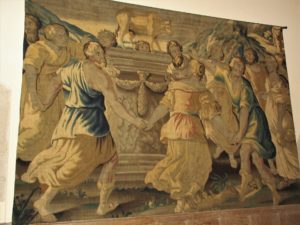Discovering Michelham Priory, an ancient house formed from an Augustine Priory, was a delight to visit recently.
You will find Michelham Priory at Upper Dicker, 2 miles west of Hailsham in East Sussex, sitting on its own island on the Cuckmere Valley and consisting of almost 8 acres in size. Michelham boasts England’s longest medieval water-filled moat. From its foundation by Augustinian canons, the moat encircles a site steeped in history which dates back to 1229, and we can discover what took place before, through its destruction from the result of the dissolution of the monasteries in Tudor times, to the time when it became a country house.
The Michelham site was cleared in the Saxon period and granted to the Norman De l’Aigle family after the Conquest. My research found that a family member, Richard de l’Aigle employed a young man called Thomas Becket, who, during a hunting expedition in the 1140s slipped from his horse on an icy bridge and fell into the river. He was swept towards a nearby mill. As luck would have it, the miller chose that moment to turn off the mill wheel, and seeing Beckett, was able to pull him to safety. Beckett, grateful for his rescue from death, decided to join the church and devote his life to God. The rest is history!
Michelham priory hosted a visit by the Archbishop of Canterbury around 1283. The priory suffered from the Black Death and in 1353 was fined for not having enough canons to fulfil its obligation to say prayers for the souls of Gilbert de Aquila and his ancestors and heirs.
Social unrest of the Peasant’s Revolt in 1381 probably made Michelham a target for peasants who thought the Duke’s money might be stored at the Priory when John Leem was Prior from 1374 to 1417 (he served John of Gaunt, Duke of Lancaster).
By 1478 the priory was in a poor state, the granges and the canons’ dormitory was falling apart as well as two mills being in ruin. The assets had to be sold, so the canons could have enough money for food to eat.
It is said that the sub prior was fined for associating with the wife of a priory servant. Other canons were told to stop visiting local taverns. The servant’s wife, Alice Ford, is said to haunt the priory grounds, even to this day!
Michelham was dissolved by Henry VIII in 1536 and was the first site given to Thomas Cromwell. After Cromwell’s execution for treason in 1540, Michelham reverted to the crown.
The King gave part of the estate to Anne of Cleeves and after her death the Priory passed through several owners before being purchased by Herbert Pelham, who began rebuilding the monastic buildings as a large house. He ran out of money and the property was sold to Thomas Sackville, Lord Brockhurst in 1601. The Sackville’s owned Michelham for the next 300 years. The Priory was let to tenants and the monastic buildings converted into a large house with outbuildings.
The house was furnished with oak-panelled rooms above the original medieval vaulted crypt.
Later, the house was used as a temporary place for evacuees during WWII and later to house a succession of military troops. The Priory is now owned by the Sussex Archaeological Society.
This is a site you can really enjoy, and you get a sense of it being a special place as soon as you pass over the moat and its 14th century gatehouse. Even children will enjoy.
Approaching the house you will see it is of stone structure and is T-shaped with the east and north wings dating from the 13th century and the west wing dating from the 16th century. The north wing, which was originally the Priors Lodging, consists of three storeys with an attic. The two other wings have two storeys. The roof is tiled.
A watermill can be seen in the grounds of the Priory, restored to working order, and is open to the public. The grounds include a kitchen, interesting physic and medieval herb gardens with modern sculptures dotted around the area.
A forge and interactive medieval gallery can be found in the 14th/early 15th century gatehouse in John Leem’s time (a basement at the gatehouse at moat level served either as a cellar or prison). The building is about 50 feet high and has 4 storeys, including the cellar. Children can enjoy themselves playing in the replica Bronze Age roundhouse, play area. There are also trails and hands-on activities available throughout the house.
A stone bridge was built over the moat in the 16th century.
Opening times are:
House & Gardens: open from Monday 17th May
Gardens only: from Saturday 20th March
Admission:
Historic Houses members visit for free
Adult £10.80
Child (5-16) £5.40
Student / Senior £9.70
Carer Free
Family £27.75 (2 adults and up to 4 children)








